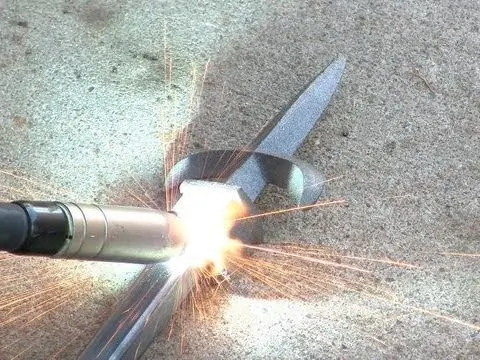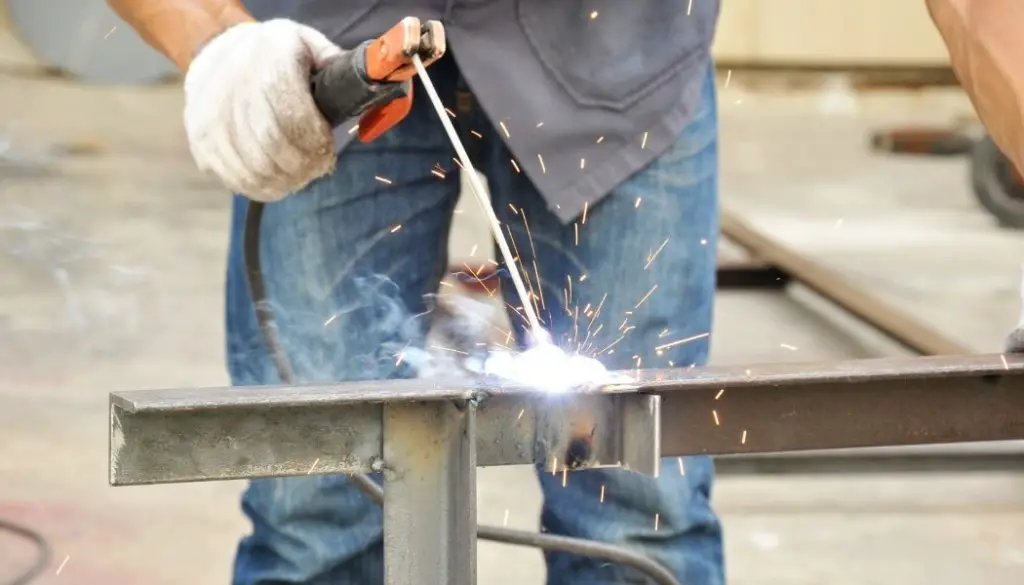Welding cast iron to steel works best when using a nickel-based filler. Nickel provides the right melting point for creating a strong joint between cast iron, which is brittle, and steel.
Table of Contents
Can You Weld Cast Iron to Steel?
You can weld cast iron to steel but must follow specific recommendations to ensure a quality joint. You can also use a variety of techniques to weld cast iron to steel, including:
- Stick welding
- MIG welding
- TIG welding
Each method has separate pros and cons due to the differences between iron and steel.

Differences Between Iron and Steel
Iron is the second most abundant metal on Earth and the most refined. Iron accounts for about 90% of all metal refined today.
Iron is a metal while steel is an alloy, meaning steel is man-made. It’s made by mixing iron, carbon, and other elements.
Some of the main differences between iron and steel include the following:
- Carbon content
- Melting point
- Impurities
The different characteristics of iron and steel impact the welding process. You may need to preheat the iron to avoid cracking or lower the temperature of the welder by adjusting the current.
Carbon Content
The carbon content is a key difference between various types of iron and steel alloys. Pure iron is soft while steel and cast iron are hard due to the carbon content.
Pure iron contains less than 0.006% carbon while cast iron can contain up to 4%. Steel contains 0.05% to 2.1% carbon.
Carbon offers increased resistance to fracturing. High carbon content can also make metal brittle.
For example, cast iron is more brittle than steel due to its high carbon content. It cracks easily under stress, such as when welding.
Melting Point
Various types of iron and steel alloys have different melting points:
- Pure iron: 2,800 degrees Fahrenheit
- Cast iron: 2,200 degrees Fahrenheit
- Low carbon (mild) steel: 2,640 to 2,800 degrees Fahrenheit
- High carbon steel: 2,600 to 2,800 degrees Fahrenheit
- Wrought iron: 2,750 degrees Fahrenheit
Carbon has a melting point of 6,422 degrees Fahrenheit.
Adding alloys to iron lowers its freezing temperature, which allows it to melt faster. Carbon adds strength but lowers the melting point, making the material more brittle.
Cast iron contains up to 4% carbon, resulting in a lower melting point than mild steel and high-carbon steel.
The inclusion of carbon also limits the expansion and contraction of the material when exposed to high temperatures.
Cast iron doesn’t expand and contract as much compared to mild steel. Steel expansion when welding increases the risk of cracking the cast iron.
Impurities
Pure iron contains impurities and inconsistent concentrations of elements. The impurities found in iron include sulfur, phosphorus, silica, and carbon.
Carbon adds strength but silica, phosphorus, and sulfur weaken the metal. The steelmaking process involves removing these impurities in a furnace.
The impurities are oxidized and float to the surface. Leaving a specific amount of carbon and adding other alloys allows steelmakers to produce steel.
Some of the impurities are removed when producing cast iron. However, cast iron retains some phosphorus, sulfur, and oils. These impurities make cast iron more porous and difficult to weld than steel.
How to Stick Weld Iron to Steel
Stick welding involves the use of a filler rod that melts into the weld pool. The rods are made of various alloys covered in flux. The flux acts as a shielding gas to protect the metal from oxidation.
Stick welding is a good choice for welding cast iron to steel, as it’s more forgiving when working with dirty or oily metals. Cast iron contains more impurities, making it more difficult to weld.
Amico 200 Amp Stick/TIG Welder
- Powerful Capable of Welding up to 3/8 inch Stainless Steel
- Almost Non-Existent Spatter and Post-Weld Cleanup
- Dual Voltage Input - 110V/230V
- 13 ft Torch Cable
- 115V or 230V Input Supply Input
- Extremely Lightweightt 18 lb with Adjustable Shoulder Strap
- Roll Cage Design
- Large TFT Screen
YESWELDER Arc Welder 205 Amp Stick Welder
- Powerful Up to 205 Amps
- Automatic Compensation for Voltage Fluctuation
- Extremely Portable at 10 lb Weight
- Very Cheap Option to Test the Waters of Stick Welding
Here are the steps involved in stick welding iron to steel:
- Choose the right filler rod
- Clean the metals
- Secure the workpieces
- Preheat the joint
- Weld small beads
Common choices for filler rods include copper rods, cast-iron-covered rods, and nickel rods.
A nickel-based filler can help increase the strength of the joint while decreasing stress on the cast iron. Nickel has a melting point of 2,650 degrees Fahrenheit, which is comparable to steel.
Clean the metals after choosing a filler rod. Use a degreaser and abrasive cleaners to clean the metals. Rinse clean with alcohol and allow to dry completely before welding.
Secure the metal using vices or clamps. Preheat the metal to at least 250 degrees Fahrenheit.
Work slowly using small beads. You should also use the fastest traveling speed to reduce direct exposure to high temperatures in concentrated areas.

How to MIG Weld Iron to Steel
Metal inert gas (MIG) welding uses a filler wire instead of a filler rod. The wire is continuously fed through the nozzle of the welding gun.
The wire is also an electrode. It completes an electrical circuit when it touches the metal.
As with stick welding, MIG welding cast iron to steel works best when you choose the right filler. A nickel wire made specifically for welding cast iron is your best bet. However, these wires are also quite expensive.
The steps involved in MIG welding iron to steel are similar to stick welding. Preheat the joint and weld small beads instead of long, continuous beads. However, you also need to use a shielding gas.
The most common choice is 75% argon with 25% CO2. The combination of gasses offers limited penetration which can help decrease the risk of cracking the cast iron.
Lincoln Electric 180 MIG Welder
- 180 Amps Can Weld 1/2" Thick Mild Steel
- Aluminum Ready Spool Gun
- 3 Year Warranty
- Extremely Reliable and Durable
- Can Weld Up to 1/4" Mild Steel
- 20% Duty Cycle at 90 Amps
- 115V Supply Only
- Includes 10 ft MIG Gun and 10 ft Work Cable with Clamp
- Infinite Voltage and Wire Feed Speed Control
- Extremely Lightweight and Portable at 19 lb
- Can Weld up to 1/4" inch Mild Steel
- 30% Duty Cycle at 90 Amps
How to TIG Weld Iron to Steel
Tungsten inert gas (TIG) welding is similar to MIG welding but relies on a non-consumable tungsten electrode to create an electric arc. A separate filler rod is held between the electrode and the joint.
As with the previous methods, the quality of the weld depends on the type of filler that you choose. Using rods intended for mild steel increases the risk of cracking. Again, you want to go with a nickel-based rod.
Amico 200 Amp Stick/TIG Welder
- Powerful Capable of Welding up to 3/8 inch Stainless Steel
- Almost Non-Existent Spatter and Post-Weld Cleanup
- Dual Voltage Input - 110V/230V
- 13 ft Torch Cable
- AC/DC TIG Welder
- Can Weld Up to 1/2 Inch Steel
- 12 ft Torch
- Complicated User Interface
Lincoln Electric 200 Amp TIG Welder
- Powerful 200 Amp TIG Welder
- Well Suited for Aluminum
- 115 or 230V Supply Voltage
- Premium TIG Welding Machine
Conclusion
Welding iron to steel isn’t always easy, whether you choose MIG welding, TIG welding, or stick welding.
Always clean the metals to remove impurities. Grease and oils limit the strength of the weld.
Preheat the metal when welding cast iron to mild steel. Preheating helps decrease the risk of cracking the cast iron.
You should also work slowly and create small beads instead of one long continuous bead. Smaller beads help keep the cast iron from overheating and cracking.








